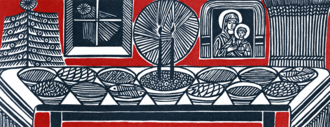Christmas in Ukraine facts for kids
Quick facts for kids Christmas in Ukraine |
|
|---|---|

|
|
| Also called | Rizdvo |
| Observed by | Christians, many non-Christians |
| Type | Christian, cultural |
| Significance | Commemoration of the Nativity of Jesus |
| Celebrations | Gift-giving, family and other social gatherings, symbolic decoration, feasting etc. |
| Observances | Church services |
| Date |
|
| Frequency | Annual |
Christmas in Ukraine is a special time filled with old traditions. It usually starts on Christmas Eve, which is January 6th. This date is based on the Julian calendar, an older way of counting days. The celebrations continue until January 19th, marking the Baptism of Jesus, known as Vodokhreschhe or Yordan.
Since 2017, December 25th, which is Christmas Day on the Gregorian calendar (the calendar most of the world uses), has also become a public holiday in Ukraine. This means people can celebrate Christmas on either December 25th or January 7th. Many churches in Ukraine, like the Eastern Orthodox Church and Ukrainian Greek Catholic Church, still follow the Julian Calendar.
Some church leaders have talked about possibly moving the main Christmas celebration to December 25th. They say this would happen when both the churches and the people are ready for such a change. This change would also affect the dates of other holidays that are celebrated on fixed days.
Contents
Sviatyi Vechir: Holy Evening Traditions
Christmas Eve in Ukraine is called Sviatyi Vechir or Sviatvechir, meaning "Holy Evening." This evening is full of old customs and rituals. Many of these traditions are even older than Christianity in Ukraine.
People decorate their homes and dinner tables with special items. These include a symbolic sheaf of wheat called the didukh, garlic, and hay. Families also sing traditional Christmas songs called koliadky or carols. Each custom has a special meaning. For example, a few wisps of hay on the tablecloth remind everyone of the manger where Jesus was born in Bethlehem.
The most important custom of the night is a special dinner called Sviata Vecheria ("Holy Supper").
The Holy Supper Meal
On Sviat vechir, Ukrainians traditionally fast, meaning they don't eat much during the day. The special supper begins only when the first star appears in the evening sky. Families gather to share a meal that usually has 12 dishes. This number can sometimes be different, from 7 to 17.
These twelve dishes are traditionally vegan, meaning they don't have meat, milk, or eggs. Fish is often included. The dishes can be different depending on the region or family. However, two dishes are always part of the meal: uzvar and kutia.
- Kutia: This dish is made from grain, honey, and poppy seeds. It's usually the first dish served. Sometimes, the head of the family will toss a spoonful of kutia at the ceiling. The number of poppy seeds that stick is believed to show how good the harvest will be in the coming year. Kutia is rarely eaten at other times of the year.
- Uzvar: This is a drink made from cooked dried fruits and berries. It can be mixed with kutia or served separately at the end of the meal.
After the meal, servings of both kutia and uzvar are often left overnight in a special corner of the house called the pokuttia. This corner is where the family icons are kept, and the food is left for the ancestors.
Koliadky: Singing Carols
After the Sviata Vecheria dinner, families often sing carols called koliadky. In many communities, groups of young people, church members, and organizations continue the old Ukrainian tradition of caroling. They visit homes, sing songs, and sometimes collect donations. A very well-known Ukrainian carol is "Boh predvichnyi narodyvsia".
Didukh: The Grandfather Spirit
In villages, which are often farming communities, the head of the household brings in a sheaf of grain called the didukh. This didukh shows how important Ukraine's ancient and rich wheat crops are. Wheat has been a main food source for centuries. The word didukh literally means "grandfather spirit," so it also represents the family's ancestors.
In Ukrainian cities, people might buy a didukh. These are often made of woven grain, dried grasses, and flowers, and they usually have three "feet" to stand on.
Shopka: Nativity Scene
A shopka is a traditional portable nativity scene. It's used to show the birth of Jesus and other figures, often in a puppet form. These scenes are a popular part of Christmas celebrations.
Images for kids
-
2006 Christmas stamp, showing St. Nicholas and children
-
Caroling in Lviv
See also
- Old New Year







